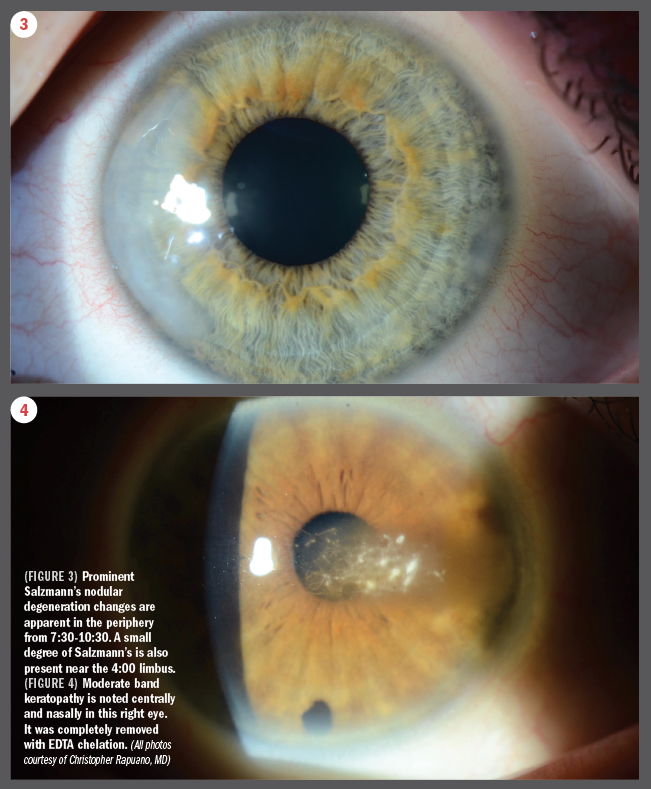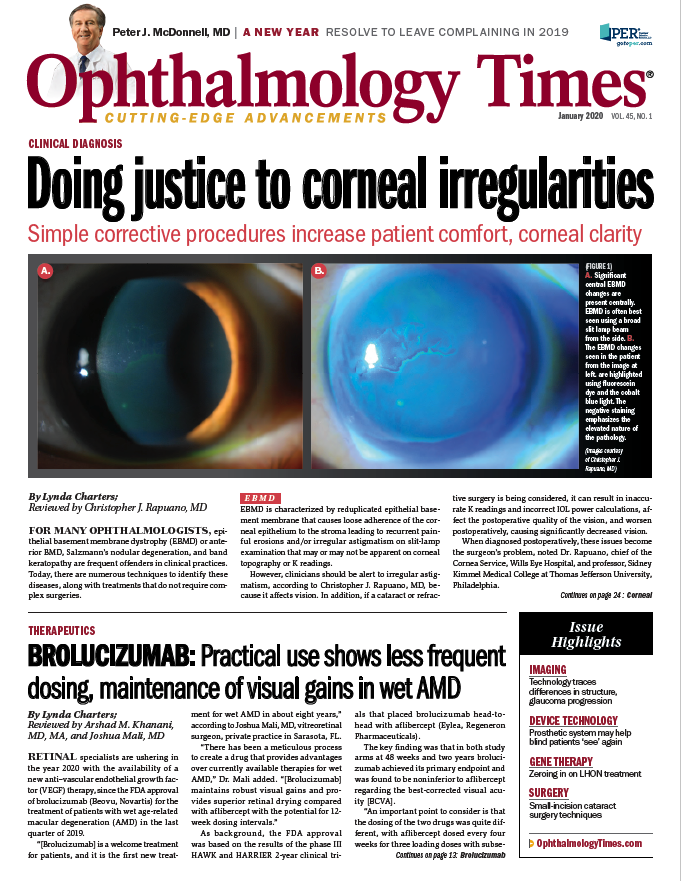Publication
Article
Digital Edition
Doing justice to corneal irregularities
Author(s):

Corneal irregularities can be treated and resolved without complicated surgery in some cases.
This article was reviewed by Christopher Rapuano, MD
For many ophthalmologists, epithelial basement membrane dystrophy (EBMD) or anterior BMD, Salzmann’s nodular degeneration, and band keratopathy are frequent offenders in clinical practices. Today, there are numerous techniques to identify these diseases, along with treatments that do not require complex surgeries.
EBMD
EBMD is characterized by reduplicated epithelial basement membrane that causes loose adherence of the corneal epithelium to the stroma leading to recurrent painful erosions and/or irregular astigmatism on slit-lamp examination that may or may not be apparent on corneal topography or K readings.
However, clinicians should be alert to irregular astigmatism, according to Christopher Rapuano, MD, because it affects vision. In addition, if a cataract or refractive surgery is being considered, it can result in inaccurate K readings and incorrect intraocular lens power calculations, affect the postoperative quality of the vision, and worsen postoperatively, causing significantly decreased vision.
Related: Advanced toric IOL calculator improves refractive outcomes
When diagnosed postoperatively, these issues become the surgeon’s problem, noted Dr. Rapuano, chief of the Cornea Service, Wills Eye Hospital, and professor, Sidney Kimmel Medical College at Thomas Jefferson University, Philadelphia.
Picking up EBMD can be tricky in some cases, but Dr. Rapuano demonstrated that fluorescein staining will often make it readily apparent. When deciding whether or not to treat, Rapuano shared some pearls that might solve the dilemma.
“If there was no negative staining or irregularity on topography or K readings centrally, then the problem probably does not require treatment,” he explained. “Conversely, consider treating if the patient is symptomatic or awaiting cataract or refractive surgery and wait about six weeks before rechecking the biometry twice to ensure the stability.”
Treatment can consist of epithelial debridement alone, or debridement in conjunction with diamond burr polishing or excimer laser phototherapeutic keratectomy (PTK). The process of debridement includes removal of all loose or irregular epithelium and basement membrane with a cellulose sponge or blade.
Related: Microscopy study suggests stem cell success in keratoconus
Dr. Rapuano said he likes to perform diamond burr polishing, which begins with epithelial debridement. He then uses a 5-mm diameter diamond-dusted burr to polish Bowman’s layer uniformly over the entire cornea for about five to six seconds to ensure that all reduplicated basement membrane has been removed.
According to Dr. Rapuano, some patients who undergo this procedure may have transient haze postoperatively that can be alleviated with steroids.
The key when performing excimer laser PTK, after debridement, he advised, is treating the entire epithelial defect with a uniform ablation of only about 5 μm.
Related: ETM valuable in planning, evaluation of outcomes
Salzmann's nodular degeneration

This pathology appears a creamy white mild to moderately elevated lesion often in the peripheral cornea, but occasionally is seen centrally. It can be associated with EBMD and can cause dry eye symptoms and irregular astigmatism despite a peripheral location.
Dr. Rapuano advised treating in the presence of any centrally located irregular astigmatism. If the patient is awaiting a cataract or refractive surgery, he also suggested waiting about six weeks after treatment before rechecking the biometry before any surgery.
Related: ETM can ease diagnosis burden for screening refractive surgery candidates
The treatment options include lamellar keratectomy using a blade with or without diamond burr polishing. In some cases, he noted, the nodules will easily peel off of Bowman’s layer and leave a smooth surface. In cases in which the underlying stroma remains unsmooth, he performs excimer laser PTK with or without mitomycin C (MMC).
If PTK is performed, he usually uses MMC. During this procedure, he advises using a blade to remove the nodules and subepithelial fibrosis and then smooth the surface with PTK. MMC 0.02% should be applied on an 8-mm sponge for 60 seconds and then irrigated with 30 cc of saline.
Ban keratopathy
This pathology, which appears as a white calcium deposit, is often related to chronic inflammation but may be idiopathic. If located centrally, the vision can be affected. However, if elevated and in the periphery vision also can be affected. In cases when it is elevated or irregular, it can cause patient discomfort.
Dr. Rapuano advised performing a workup to determine the etiology.
Related: Facing challenge of corneal infection management in operated eyes
The treatment is ethylenediaminetetraacetic acid (EDTA) chelation. The key point in this procedure is removal of the epithelium over all of the calcium using a number 15 blade or Tooke knife. The presence of any epithelium will prevent absorption of the EDTA. Diluted EDTA 3% to 4% should be applied to the calcium on a cellulose sponge or cotton-tipped applicator for 10 to 45 minutes until all of the calcium has dissolved.
“Corneal irregularities and opacities are common and they can affect comfort, clarity, and corneal curvature, making it especially important to diagnose before cataract and refractive surgeries,” Dr. Rapuano concluded. “There are numerous techniques to identify them, and there are excellent treatment options for clinically relevant pathology.”
Read more by Lynda Charters
Christopher Rapuano, MD
E: cjrapuano@willseye.org
This article is based on Dr. Rapuano’s presentation at the American Academy of Ophthalmology 2019 annual meeting. Dr. Rapuano has no financial interest in any aspect of this report.
Newsletter
Don’t miss out—get Ophthalmology Times updates on the latest clinical advancements and expert interviews, straight to your inbox.





